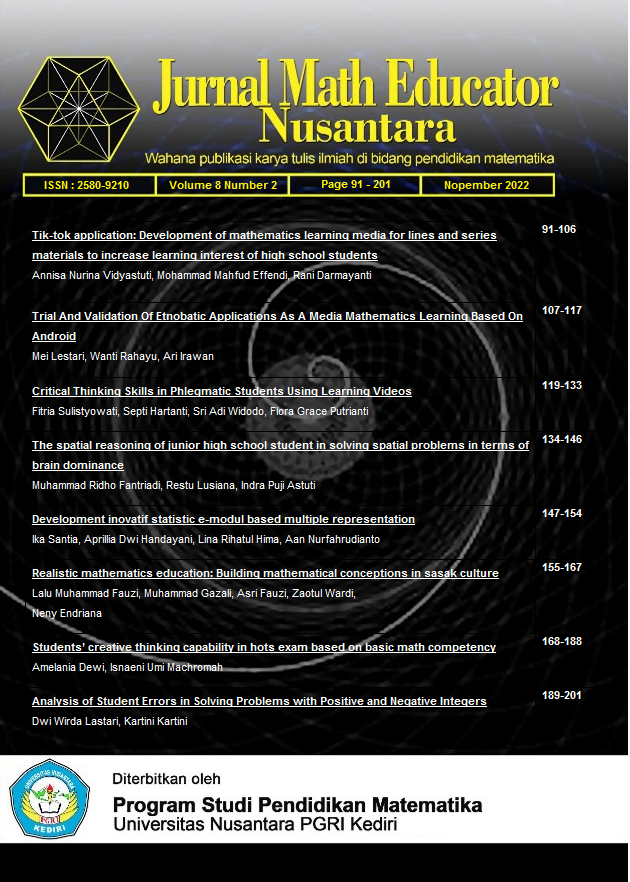Analysis of Student Errors in Solving Problems with Positive and Negative Integers
DOI:
https://doi.org/10.29407/jmen.v8i2.18308Keywords:
Types of Kastolan Error, Concept Error, Procedure Error, Count Operation Error, positive and negative integersAbstract
This study aims to analyzes alsos describestype of error the students did based on Kastolan to solveproblem with positive and negative integers. The subjects in this study there are 16 students from class VII Pondok Pesantren MTs As-Sakinah, Kampar Regency. The type of research is descriptive qualitative. Data collections technics carried out from the form of written tests also interviews. Written test is arranged in a forms of a description of 5 questions. The data analysis techniques carried out were: correcting the results of students' answers; identify and analyze errors that students did to answer questions based on types of Kastolan errors; count percentages of errors on every items in every types of error; percentage results are categorized by error percentage; the counted data will be analyses descriptively with interpreting results of calculating the percentage of student errors; and draw conclusion. The results of the analysis of student errors, it was obtained that 18.2% of students made conceptual errors with very low error categories, 42.4% of students made procedural errors with sufficient error categories, and 39.4% of students made arithmetical errors with low error categories.
References
Amir, Z., & Risnawati. (2015). Psikologi Pembelajaran Matematika. Aswaja Pressindo.
Anggito, A., & Setiawan, J. (2018). Metodologi Penelitian Kualitatif. CV Jejak Publisher.
Dwi Listiana, A., & Sutriyono, S. (2018). Analisis Kesalahan Siswa Dalam Menyelesaikan Soal Cerita Pada Materi Himpunan Bagi Siswa Kelas Vii Smp. Pendekar : Jurnal Pendidikan Berkarakter, 1(1), 60. https://doi.org/10.31764/pendekar.v1i1.280
Effendi, R. (2022). Analisis Kesalahan Menyelesaikan Soal Perpangkatan dan Bentuk Akar pada Siswa Kelas IX.6 SMPN 2 Lahat. Jurnal Pendidikan Matematika Undiksha, 13(1), 39–47. https://doi.org/10.23887/jjpm.v13i1.41001
Firdaus, E. F., Amalia, S. R., & Zumeira, A. F. (2021). Analisis Kesalahan Siswa Berdasarkan Tahapan Kastolan dalam Menyelesaikan Soal Matematika. Dialektika P. Matematika, 8(1), 542–558.
Jalaludin, M. A., & Sari, V. T. A. (2018). Analisis Kesalahan Siswa dalam Menyelesaikan Soal Bilangan Berpangkat pada Siswa kelas X SMK Swasta di Kota Cimahi. Jurnal Pendidikan Tambusai, 2(6), 1796–1801. https://www.jptam.org/index.php/jptam/article/download/172/162
Lagalante, R., Suharna, H., & Tonra, W. S. (2022). Analisis Kesalahan Siswa dalam Menyelesaikan Masalah Matematika pada Bilangan Perpangkatan dan Bentuk Akar. Jurnal Pendidikan Guru Matematika, 2(2), 184–192.
Lenterawati, B. S., Pramudya, I., & Kuswardi, Y. (2018). Analisis Kesalahan Berdasarkan Tahapan Kastolan dalam Menyelesaikan Soal Cerita Sistem Persamaan Linear Dua Variabel Ditinjau dari Gaya Berpikir Siswa Kelas VIII SMP Negeri 19 Surakarta Tahun Pelajaran 2018/2019. Jurnal Pendidikan Matematika Dan Matematika (JPPM), 11(6), 471–482. https://jurnal.uns.ac.id/JMMS/article/view/38031/25107
Mauliandri, R., & Kartini, K. (2020). Analisis Kesalahan Siswa Menurut Kastolan dalam Menyelesaikan Soal Operasi Bentuk Aljabar pada Siswa SMP. AXIOM : Jurnal Pendidikan Dan Matematika, 9(2), 107–123. https://doi.org/10.30821/axiom.v9i2.7687
Meldawati, M., & Kartini, K. (2021). Analisis Kesalahan Siswa Kelas VII SMP dalam Menyelesaikan Soal Matematika pada Materi Bilangan Berpangkat Bulat Positif. AXIOM : Jurnal Pendidikan Dan Matematika, 10(1), 1. https://doi.org/10.30821/axiom.v10i1.7681
Mulbar, U., Nasrullah, & Yulinar. (2022). Analisis Kesalahan Siswa dalam Menyelesaikan Soal Perpangkatan dan Bentuk Akar Berdasarkan Kriteria Watson dinjau dari Perbedaan Gender. Issues in Mathematics Education, 6(1), 10–24.
Oktarina, P. N., Kudadiri, N. F., & Ramadhan, A. (2022). Analisis Kejenuhan Peserta Didik dalam Pembelajaran Matematika pada Materi Perpangkatan (Bilangan Berpangkat, Perkalian dan Pembagian pada Perpangkatan) Secara Daring. Jurnal Ilmiah Pendidikan, 1(1), 17–24. https://doi.org/https://doi.org/10.55904/educenter.v1i1.8
Permendikbud, P. (2016). Undang-Undang Republik Indonesia Nomor 21 Tahun 2016 tentang Standar Isi Pendidikan Dasar dan Menengah.
Putri, F. L., Sarjoko, & Hamdani, H. M. (2022). Identifikasi Kesalahan Siswa dalam Menyelesaikan Soal Bilangan Berpangkat dan Bentuk Akar di Kelas IX SMPN 2 Tasik Payawan. Jurnal Pendidikan, 23(1), 1–9. http://jurnal.untad.ac.id/jurnal/index.php/Kreatif/article/view/3356/2392
Siagian, P., & Surya, E. (2021). Analisis Kesalahan Siswa dalam Menyelesaikan Soal Matematika pada Materi Perpangkatan dan Bentuk Akar. INNOVATIVE: Journal Of Social Science Research, 1(1), 32–35. https://doi.org/10.31004/innovative.v1i1.2033
Sukmana, E. I., & Arhasy, H. E. A. R. (2019). Analisis Kesalahan Siswa dalam Menyelesaikan Soal Bilangan Berpangkat dan Bentuk Akar pada Siswa Kelas X SMK Negeri 1 Kawali Tahun Ajaran 2018/2019. Prosiding Seminar Nasional & Call For Papers Program Studi Magister Pendidikan Matematika Universitas Siliwangi, 176–186.
Sulistio, W., Muhsetyo, G., & Qohar, A. (2019). Klasifikasi Kesalahan Siswa Kelas VII Menggunakan Model KIAT tentang Materi Himpunan. Jurnal Pendidikan: Teori, Penelitian, Dan Pengembangan, 4(6), 706. https://doi.org/10.17977/jptpp.v4i6.12477
Sulistyaningsih, A., & Rakhmawati, E. (2017). Analisis Kesalahan Siswa Menurut Kastolan dalam Pemecahan Masalah Matematika. Seminar Matematika Dan Pendidikan Matematika Uny, 19(2), 123–130.
Tuzahrah, F., R, Z., & Ijuddin, R. (2016). Analisis Kesulitan Belajar Siswa dalam Menyelesaikan Soal Bilangan Berpangkat di Kelas X SMA. Jurnal Pendidikan Dan Pembelajaran, 5(10), 1–12. https://jurnal.untan.ac.id/index.php/jpdpb/article/view/17113
Wardana, A. W., & Fitriyani, H. (2020). Kesalahan Siswa SMK Jurusan Busana dalam Menyelesaikan Soal Bilangan. AdMathEduSt: Jurnal Ilmiah Mahasiswa Pendidikan Matematika, 7(2), 118–123. https://doi.org/http://dx.doi.org/10.12928/admathedust.v7i2.22492
Yulanda, R., & Yarman, Y. (2018). Analisis Kesalahan Peserta Didik Berdasarkan Tahapan Kastolan dalam Menyelesaikan Soal Matematika Materi Trigonometri Kelas XI IPA SMA Negeri 2 Pariaman. Jurnal Edukasi Dan Penelitian Matematika, 7(4), 121–126.
Downloads
Published
Issue
Section
License
Authors who publish with this journal agree to the following terms:
- Copyright on any article is retained by the author(s).
- The author grants the journal, the right of first publication with the work simultaneously licensed under a Creative Commons Attribution License that allows others to share the work with an acknowledgment of the work’s authorship and initial publication in this journal.
- Authors are able to enter into separate, additional contractual arrangements for the non-exclusive distribution of the journal’s published version of the work (e.g., post it to an institutional repository or publish it in a book), with an acknowledgment of its initial publication in this journal.
- Authors are permitted and encouraged to post their work online (e.g., in institutional repositories or on their website) prior to and during the submission process, as it can lead to productive exchanges, as well as earlier and greater citation of published work.
- The article and any associated published material is distributed under the Creative Commons Attribution-ShareAlike 4.0 International License
















